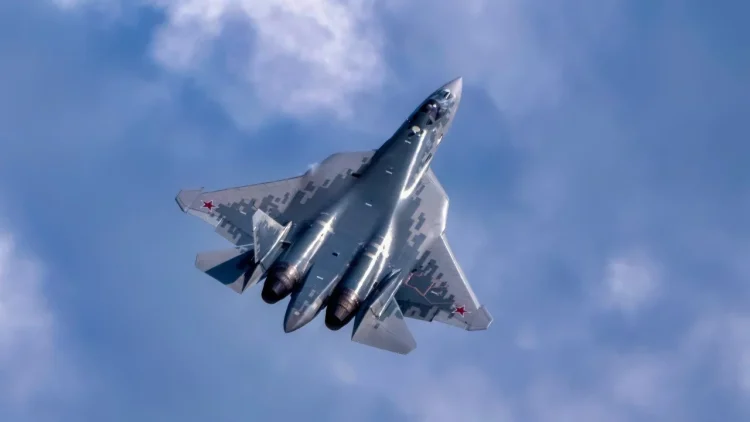The Sukhoi Su-57: A Leap into the Future of Air Combat

fifth-generation multirole stealth fighter developed by Sukhoi, a subsidiary of United Aircraft Corporation in Russia. It represents a significant leap in aerial warfare technology, showcasing advancements in stealth, avionics, and weapons systems. With its first flight in 2010, the Su-57 has emerged as a symbol of Russia’s ambition to modernize its military and maintain parity with Western counterparts like the F-22 and F-35. This article delves into the design, capabilities, operational history, and the geopolitical implications of the Su-57.
Historical Context
The development of the Su-57 began in the early 2000s as Russia recognized the need for a next-generation fighter to replace its aging fleet of fourth-generation aircraft. The collapse of the Soviet Union led to a significant decline in military spending, which hampered the development of new technologies. However, as geopolitical tensions escalated in the late 2000s, particularly with NATO expansion and conflicts in the post-Soviet space, Russia sought to reinvigorate its military capabilities.
The Su-57 project was initiated to develop a stealthy, multirole aircraft capable of engaging air, ground, and naval targets. The aircraft was designed to integrate advanced technologies, including low-observable features, supercruise capability, advanced avionics, and a suite of modern weapons.
Design and Features
Stealth Characteristics
One of the defining features of the Su-57 is its stealth capabilities. The aircraft’s design incorporates a blended wing-body configuration, which reduces radar cross-section and enhances aerodynamic efficiency. The use of radar-absorbent materials (RAM) and an internal weapons bay further contribute to its low observability. These features allow the Su-57 to operate effectively in contested environments, making it difficult for enemy radar systems to detect and track.
Supercruise and Performance
The Su-57 is powered by two Saturn AL-41F1 engines, which enable supercruise capability—sustained supersonic flight without afterburners. This feature not only enhances fuel efficiency but also allows the aircraft to maintain higher speeds during engagements. The fighter has a maximum speed of approximately Mach 2.0 and a service ceiling of around 20,000 meters (65,617 feet).
The aircraft’s agility is further augmented by its advanced flight control systems, which allow for exceptional maneuverability. The thrust vectoring nozzles provide the Su-57 with unmatched dogfighting capabilities, enabling it to execute complex aerial maneuvers and maintain an advantage in close-quarters combat.
Avionics and Sensor Suite
The Su-57 is equipped with cutting-edge avionics and sensor systems that enhance situational awareness and target acquisition. The aircraft features a digital fly-by-wire control system, advanced radar systems, and an integrated electronic warfare suite.
The Irbis-E radar, a key component of the Su-57, utilizes an active electronically scanned array (AESA) design, allowing for simultaneous tracking of multiple targets and engagement of ground and aerial threats. The radar’s advanced signal processing capabilities enable it to detect stealthy targets, giving the Su-57 a significant edge in aerial combat.
In addition to the radar, the Su-57 incorporates an infrared search and track (IRST) system, which allows for passive detection of enemy aircraft. This capability is crucial for engaging threats without revealing the fighter’s position.
Armament
The Su-57 is designed to carry a wide variety of munitions, including air-to-air missiles, air-to-ground missiles, and precision-guided bombs. The internal weapons bay can house a combination of R-37 long-range air-to-air missiles, Kh-59 cruise missiles, and various guided bombs, maximizing its combat effectiveness while maintaining stealth.
Operational History
The Su-57 made its public debut in 2016 during the MAKS Airshow in Zhukovsky, Russia, and has since undergone extensive testing. The aircraft was officially introduced into service with the Russian Air Force in December 2020, with the first operational squadron, the 929th State Flight Test Center, receiving the aircraft.
Despite its introduction, the Su-57 has faced various challenges in its development and production processes. Initially, the program was marred by delays and budget constraints, primarily due to economic difficulties following the annexation of Crimea and the subsequent imposition of Western sanctions. These factors have impacted the production rate and operational deployment of the aircraft.
Combat Experience
While the Su-57 has yet to see extensive combat, it has been deployed in limited operational roles, primarily in Syria. Russian officials have claimed that the aircraft conducted airstrikes and provided support to ground forces, showcasing its capabilities in a real-world environment. However, independent assessments of its performance have been limited, and the true effectiveness of the Su-57 remains to be fully evaluated in combat scenarios.
Geopolitical Implications
The development and deployment of the Su-57 have significant implications for global military balance and security dynamics. As a fifth-generation fighter, the Su-57 challenges the dominance of Western airpower, particularly the United States and its allies.
Regional Influence
The Su-57’s introduction into the Russian military arsenal enhances its regional influence, particularly in the context of the ongoing conflicts in Ukraine and Syria. The aircraft’s advanced capabilities provide the Russian military with a potent tool for deterrence and power projection. Moreover, the Su-57’s presence serves as a counterbalance to NATO forces in Eastern Europe, underscoring Russia’s commitment to maintaining its military superiority.
Export Potential
The Su-57’s development also opens avenues for defense exports, as Russia seeks to market the aircraft to countries interested in acquiring advanced fighter capabilities. India, which participated in the initial phases of the PAK FA program, has expressed interest in the aircraft, although negotiations have faced hurdles. Other countries, particularly in Southeast Asia and the Middle East, may view the Su-57 as an attractive alternative to Western aircraft, especially in light of geopolitical considerations and defense partnerships.
Comparison with Western Counterparts
To understand the Su-57’s capabilities fully, it is essential to compare it with its Western counterparts, primarily the F-22 Raptor and F-35 Lightning II.
F-22 Raptor
The F-22 Raptor, developed by Lockheed Martin, is widely regarded as the most advanced air superiority fighter in the world. Its combination of stealth, speed, and agility sets it apart from previous generations of aircraft. The Raptor is designed primarily for air-to-air combat, featuring an advanced AESA radar system and supercruise capability.
While the Su-57 offers comparable agility and stealth features, the F-22’s operational history and combat experience give it an edge in air superiority. The F-22 has proven itself in various combat scenarios, while the Su-57’s performance remains largely untested in extensive engagements.
F-35 Lightning II
The F-35, another product of Lockheed Martin, is designed as a multirole stealth fighter capable of operating in various environments. Its modular design and advanced avionics make it highly adaptable for ground attack, intelligence gathering, and air-to-air combat.
In terms of capabilities, the Su-57 may excel in agility and raw performance, but the F-35’s extensive sensor fusion capabilities and network-centric warfare capabilities provide it with a significant advantage in modern combat scenarios. The F-35’s ability to integrate data from multiple sources enhances situational awareness, making it a formidable opponent.
Future Prospects
The future of the Su-57 program hinges on several factors, including technological advancements, production rates, and geopolitical considerations. As Russia continues to modernize its military, the Su-57 is expected to play a pivotal role in its strategic planning.
Technological Upgrades
To maintain its competitiveness, the Su-57 will likely undergo continuous upgrades to enhance its capabilities. Future iterations may include improved avionics, advanced weapon systems, and enhanced stealth features. The integration of artificial intelligence and machine learning technologies may also play a crucial role in enhancing the aircraft’s combat capabilities and decision-making processes.
Production and Operational Readiness
The pace of Su-57 production will be critical to its operational readiness and impact on military strategy. Russia aims to produce a significant number of Su-57s to equip its air force adequately. However, economic constraints and production challenges may affect the timeline for full operational deployment.
Geopolitical Dynamics
As geopolitical tensions persist, the demand for advanced military capabilities will likely continue to rise. The Su-57’s role in Russia’s military strategy will evolve as it seeks to assert its influence in various regions. The aircraft may serve as a deterrent against perceived threats from NATO and other adversaries, reinforcing Russia’s position as a global military power.
Conclusion
The Sukhoi Su-57 represents a significant advancement in the realm of air combat, showcasing Russia’s commitment to modernizing its military capabilities. With its stealth features, supercruise capability, and advanced avionics, the Su-57 is poised to challenge Western air superiority in the coming years. However, its operational history remains limited, and the true effectiveness of the aircraft in combat scenarios is yet to be fully realized.





